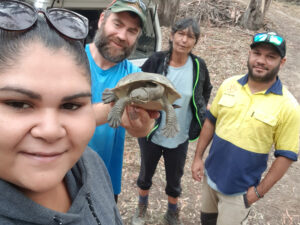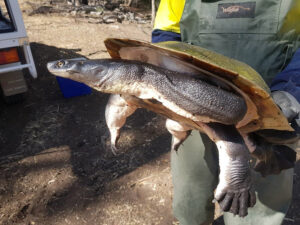A team led by James Van Dyke (La Trobe University), and Joseph Briggs, Liticia Ross, Tracy Hamilton, and Brandon Cooper from Yarkuwa Indigenous Knowledge Centre in Deniliquin are studying turtle populations at six wetlands along the Edward/Kolety River system, from Deniliquin to Balpool Road Bridge. The aim of this study is to determine whether connectivity of wetlands affects turtle distribution, movement, and body condition.
The team are doing this by trapping and measuring turtles, and at the same time following the movements of 24 Murray River turtles (Emydura macquarii, also known as short-necked turtles) that have been tagged with acoustic tags to see how they move in and out of wetlands throughout the year.
Their work will examine whether wetlands that are disconnected from the river and at risk of drying during winter, are unsuitable for turtles, because winter drying would mean that they would be suddenly exposed to the elements and predation by foxes. This is a risk because turtles are ectotherms, and during winter their body processes slow due to cold temperatures to the point that they cannot be very active.
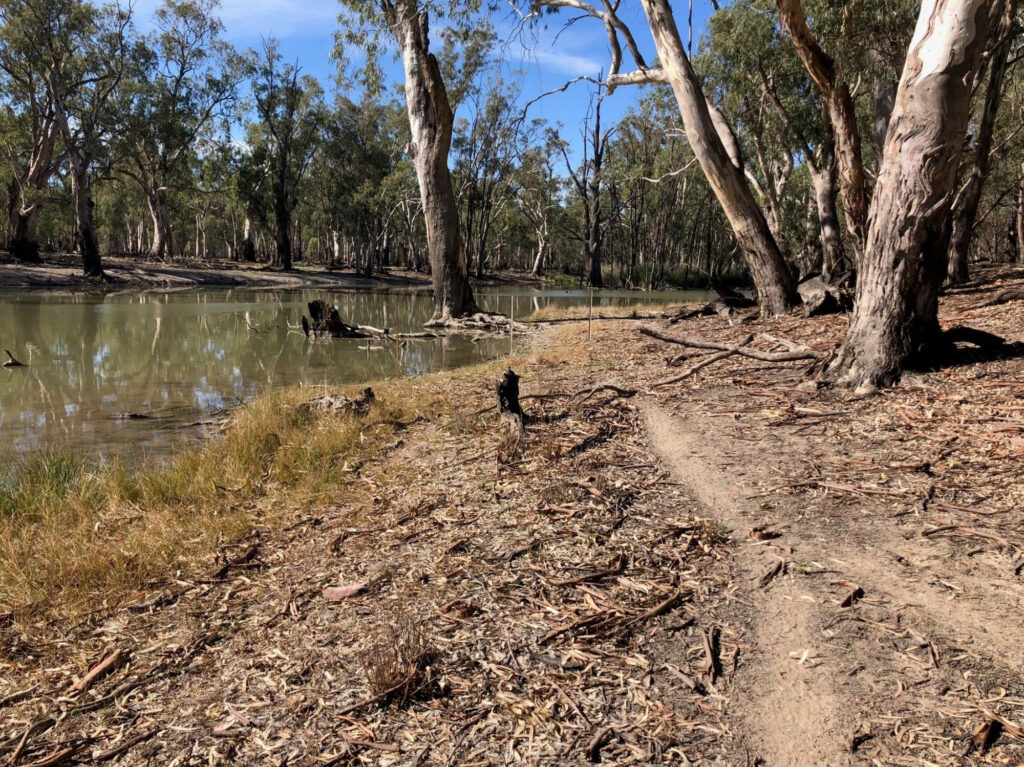
Environmental watering helps connect wetlands to the river and allows turtles to swim between them without crossing overland, where foxes are likely to prey on them.
The involvement of the Yarkuwa Indigenous Knowledge Centre has enabled local knowledge and experience to drive the project’s success, as well as providing the opportunity for Joseph, Liticia, Tracy and Brandon to learn new skills about how to trap, handle, and measure turtles, as well as being able to monitor turtle populations. The turtle project is a great example of local people making a significant contribution to environmental research and management projects.
Over the summer of 2019-20 the team caught 143 broad-shelled turtles (Chelodina expansa), 139 eastern long-necked turtles (C. longicollis), and 209 Murray River turtles (E. macquarii). By February 2020, 20-30% of the turtles caught were individuals that we had caught and marked in previous trapping sessions, which suggests that we are surveying a considerable portion of the local turtle population. Due to the dry summer, one of our lagoon sites had begun to dry. There was some water in this wetland but we caught no turtles there after December. We also had relatively low catch rates at Moonahcullah Lagoon and our highest catch rate was at Dahwilly Lagoon, near Deniliquin.
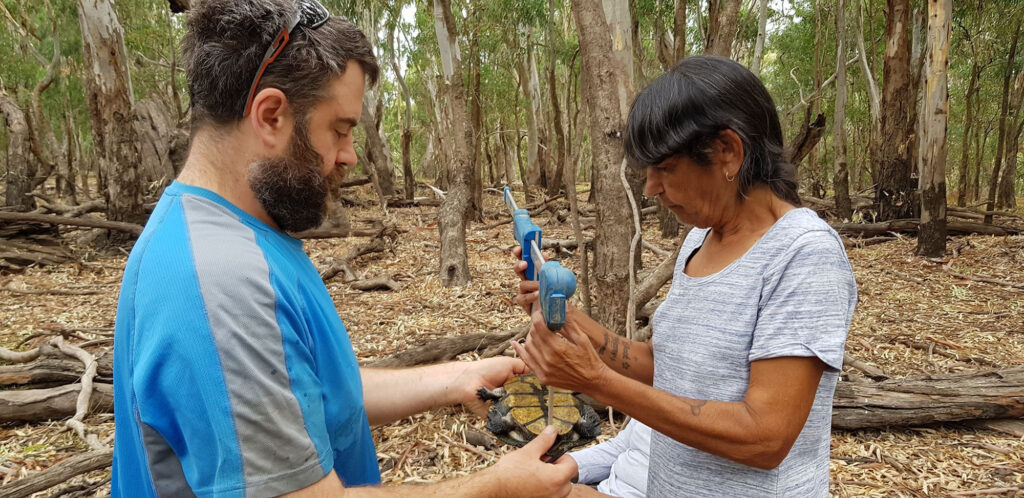
Tracy Hamilton measures the shell of a large eastern long-necked turtle that James holds.
The movements of 24 tagged Murray River turtles have been monitored since October 2019. The team aimed to tag two male and two female turtles at each of six lagoons, however, they could catch only one male at two of the sites so they tagged three females at these two lagoons. The results are that the movements of 10 male and 14 females are now being tracked.
Of the 24 turtles that we tagged, 20 moved into the river rather than stay in their home wetlands, especially at the beginning of winter. This suggests that Murray River turtles usually move into the river to overwinter, which would protect them from experiencing winter drying of their home wetlands. This behaviour may represent an adaptation turtles have to surviving in wetland systems that are prone to drying over winter.
Interestingly, the males and females behaved differently. The male turtles all left their home wetlands over the summer and entered the river system. Five of the 10 males disappeared, and have not been detected since. Of the other five, three have moved up or downstream 5 to 20 km to other wetlands in our study area. This includes one male that swam from Barratta Lagoon to Moonahcullah Lagoon, and another male that made the same trip in the opposite direction (see image below). The last two males have stayed in the river close to their home wetland.
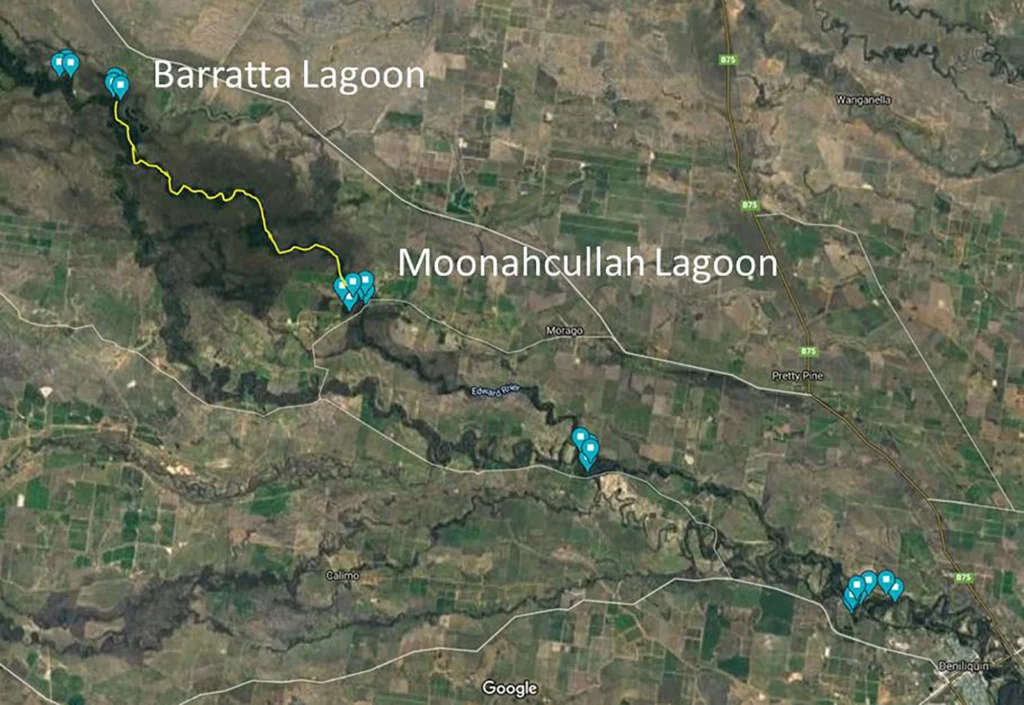
In contrast, four of the females have stayed in their home wetland, though they have occasionally moved back and forth between the lagoon and the river. All of the remaining 10 females left their home wetlands by May 2020, and five of these stayed in the river adjacent to their home wetland over winter. The remaining five moved out of range of the acoustic receiver stations over winter, but two that had overwintered in the river moved back into their home wetland in late August and early September 2020.
We will be trapping turtles again through the 2020-21 summer and will retrieve the receivers in February. We hope the results will reveal what the turtle do as we transition into spring and summer.
